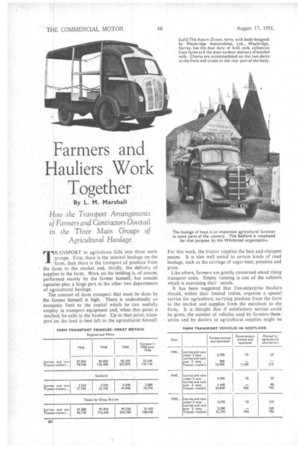Farmers and Hauliers Work Together
Page 40

Page 41

If you've noticed an error in this article please click here to report it so we can fix it.
By L. M. Marshall " HOW the Transport Arrangements of Farmers and Contractors Dovetail in the Three Main Groups of Agricultural Haltlage TRANSPORT in agriculture falls into three main groups. First,. there is the internal haulage on the farm, then there is the transport of produce from the farm to the market and, thirdly, the delivery of supplies to the farm. Work on the holding is, of course, performed mainly by the farmer himself, but outside agencies play a large part in the other two departments of agricultural haulage.
The amount of farm transport that must be done by the farmer himself is high. There is undoubtedly an economic limit to the capital which he can usefully employ in transport equipment and, when that point is reached, he calls in the haulier. Up to that point, transport on the land is best left to the agriculturist himself. For this work, the tractor supplies the best and cheapest means. It is also well suited to certain kinds of road haulage, such as the carriage of sugar-beet, potatoes and grain.
Like others, farmers are greatly concerned about rising transport costs. Empty running is one of the subjects which is exercising their minds.
It has been suggested that free-enterprise hauliers should, within their limited radius, organize a special service for agriculture, carrying produce from the farm to the market and supplies from the merchant to the farm. It is thought that if satisfactory service could be given, the number of vehicles used by farmers themselves and by dealers in agricultural supplies might be reduced, and that the cost of agricultural production might thereby be cut. Another suggestion is that farmers should combine to do more haulage under C licences, but this proposal would obviously not find favour with professional hauliers and their sympathy with the farmer might be alienated Among the services for which the farmer must rely largely on the contractor are those of livestock haulage and milk transport. Milk haulage is a highly specialized business and its efficiency has a close bearing on the retail cost of milk.
To reduce time in transit, all unnecessary handling points must be avoided. In fact, the provision of new
handling centres at the best strategic points has failed to keep pace with the rapid improvement in road transport services during the past 20 years or so and is, at• present, the greatest hindrance to a reduction in the time gap between the producer and consumer.
The. magnitude of the business of transporting milk from farms in England and Wales is indicated by the annual turnover of £4m. Dur ing the past few. years, much rationalization has taken place and it was estimated that these measures had, up to May, 1950,. savedllm. Up to the end'of Ma:rch, 1950, it was officially estimated that of the 1,360rm gallons of milk produced in the year by wholesale producers, the Milk Marketing Board controlled the transport to depots of 741m. gallons, Of this amount, 178m. gallons went into manufacture and 563m. gallons were conveyed from the depots—about two-thirds by road and one-third by rail —to wholesalers and retailers in towns. In addition, the M.M.B. controlled the conveyance of 619m. gallons —nearly all by road—direct to wholesalers and retailers in towns, making a total distributed to wholesalers and retailers of 1, 182m gallons 'in the year.
From the depot to the consumer, transport was in the hands of private undertakings. Producer-retailers were responsible for the production of an additional 159M. gallons during the year, the transport of which was dealt with entirely by private means.
The Board estimates that in England and Wales, milk has to travel from 140,000 farms to over 7,000 separate destinations. Half the milk handled has to make a second and sometimes a third journey. All this work has to be done 365 days .of the year.
The gross weight of milk, including containers, handled on primary and secondary haulage is nearly 20m. tons a year. Some 10,000 vehicles are employed in collecting and delivering milk to the first destination. About half of them are vans and the remainder are lorries, mostly 5-tonners.
The extent of farm transport is revealed partly by
the official census figures of recent years, which show a large number of vehicles engaged in agriculture. By far the largest proportion is known to be operated by farmers themselves.
In Scotland, the numbers of vehicles are smaller, but . the censuses are taken in greater detail and show that since 1946 there has been a tendency for more work to be done by contractors.




















































































